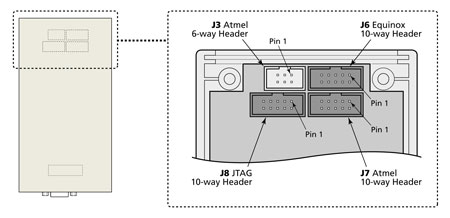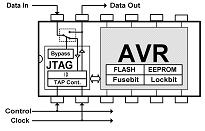| |
Advantages of the new FS2003 Programmer: |
|
|
|
|
|
|
 |
Programming Speed |
|
- The FS2003 internal electronics run almost twice as fast as the FS2000A.
-
This means that any device algorithm which is dependent on processing power will execute significantly faster e.g. Atmel ATmega SPI and JTAG algorithms.
|
 |
On-board FLASH Project Memory Storage |
|
- The FS2003 has 4Mbytes of on-board FLASH Memory compared to 0.5MBytes on the FS2000A.
-
This means that the FS2003 can store up to 8 x more data in Standalone Mode.
-
Up to 28 full projects for the Atmel ATmega128 microcontrollers could be uploaded to the FS2003 (128kb FLASH + 4kb EEPROM)
|
 |
Enhanced Device Support |
|
|
The FS2003 features enhanced device support compared with the FS2000A:
- Atmel AT89C51Rx2 / CC0x - 8051 FLASH Microcontroller Family
- Atmel ATmega JTAG In-System Programming (chargeable upgrade)
- Atmel ATtiny11/12/15 High Voltage Programming Mode
- Philips P89CRx2 / 66x - 8051 FLASH Microcontroller Family
|
 |
Enhanced Target Interface Capabilities |
|
|
The FS2003 supports the following Target Interfaces / Algorithms:
- Atmel AVR - SPI - Serial Programming Mode
- Atmel AT89S - SPI - Serial Programming Mode
- Atmel ATtiny11/12/15 High-Voltage Serial Programming Mode
- UART Boot Loader - for Atmel T89C51Rx2 8051 microcontrollers
- UART Boot Loader - for Philips P89C51Rx2 and P89C66x 8051 microcontrollers
- Atmel ATmega JTAG In-System Programming (ISP) - chargeable upgrade
The FS200A only supports:
Atmel AVR - SPI - Serial Programming Mode
Atmel AT89S - SPI - Serial Programming Mode
|
 |
On-board ISP Headers |
|
|

The FS2003 features the FOUR most popular ISP Header connector configurations:
- Equinox 10-way - SPI / UART
- Atmel 10-way - SPI
- Atmel 6-way - SPI
- Atmel 10-way - JTAG (same as JTAG-ICE connector)
The FS2000A only features the following TWO ISP Header connector configurations:
- Equinox 10-way - SPI
- Atmel 10-way - SPI
|
 |
Supports powering from any Target System Voltage between 3.0 and 5.0V |
|
- The FS2003 can be powered from the Target System via the ISP Cable at 3.0 - 5.0V.
- The FS2000 can only be powered from a 5.0V Target System. When programming at <5.0V, the Target System and the Programmer must be independently powered.
|
 |
Supports JTAG Programming Algorithm |
|
|

The FS2003 supports programming of the Atmel ATmega AVR Microcontroller Family using the JTAG algorithm. This chargeable upgrade allows the FS2003 to program the ATmega devices at high speed using the JTAG port.
The advantages of JTAG In-System Programming are:
- Much faster programming times
- JTAG port can also be used as a 'Debug Port' during product development
|
 |
Supports ATtiny11/12/15 - High Voltage Programming Mode |
|
|
The FS2003 supports In-System Programming of the Atmel ATtiny11 / 12 / 15 AVR Microcontrollers using the 'High-Voltage - Serial Programming Mode'.
This mode has the following advantages over the standard SPI mode:
- Faster programming (it is effectively parallel programming)
- Allows a device to be recovered after the 'RSTDISBL' fuse has been ENABLED.
|
 |
Configurable Frequency Output Clock |
|
|
The FS2003 is capable of outputting a continuous square wave at various frequencies on the programmer SCK2 pin.
This clock frequncy could be used for the following purposes:
- To toggle the STROBE pin on a Watchdog Timer IC to stop the IC from timing out during the In-System Programming operation.
- To provide a clock to an Atmel ATmega microcontroller to resurrect a device which has an incorrectly configured Internal Oscillator.
|
 |
Individually configurable Programmer I/O pins |
|
|
Each pin of the FS2003 programmer is individually configurable via the Pre-programming State Machine to any of the following states:
- TRI - TRI-STATE
- LAH - Logic Active High
- LAL - Logic Active Low
- ODH - Output Driven High
- ODL - Output Driven Low
The FS200A output stage is either always driving every pin or every pin is tri-state.
|
 |
Spare Programmer I/O pins |
|
- The FS2003 has TWO more I/O pins compared with the FS2000A.
- This allows the FS2003 to supports the full JTAG I/O specification.
- In SPI mode, there are 2 x Spare I/O pins for custom use.
- In UART mode, there is 1 x Spare I/O pins for custom use.
- The spare I/O pin(s) can be used for controlling circuitry on the user Target System including Chip Selects, additional RESET control lines, Watchdog Timers etc.
|
 |
Optional Backlit Display |
|
|
The FS2003 display can be backlit by fitting an internal jumper.
|
| |